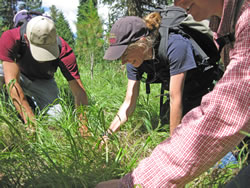
National Fire Plan Success Story
Fire, Exotics Management Collaborate in War against Weeds
Grand Teton National Park, Wyoming
National Fire Plan - Fuels Reduction
2010

Fire ecologist Diane Abendroth, plant biologist Jason Brengle and an exotic vegetation crew member look for weeds in the Phelps Moraine prescribed fire project area.
The mere mention of invasive, exotic plants in a burn unit can complicate or even derail a prescribed fire project, but fire and resource management personnel at Grand Teton found common ground on the Phelps Moraine project to address the weeds and still move forward on an important fuels project.
Thirty-two NPS and U.S. Forest Service employees, from fire management as well as science and resource management, joined forces to map weeds in the 473-acre Phelps Moraine prescribed fire unit.
Organizers originally planned to map and spray weeds during the two-day project, but rainy weather hampered the spraying effort. Instead five squads using GPS units fanned out and gridded the burn unit, focusing on mapping any invasives. The exotic vegetation crew will return and spray the weeds prior to the prescribed fire, which is planned for mid-September to early October, 2010, when weather and fuels conditions fall within prescription.
“We realized during a Resource Council meeting that to implement this prescribed fire, we had to find a workable solution for dealing with invasives,” said Deb Flowers, prescribed fire technician and burn boss. “Our mapping project showed a significant presence of St. John’s Wort, Oxeye Daisy, Hound’s Tongue, and Musk and Canadian Thistle.”
The heaviest concentration of weeds was near two roads, a popular horse trail and a historic ranch. Fire management worked with resource advisors to select an 84-acre test burn area where weed response can be monitored.
“The exotics are problematic, and mitigating them will be essential to the success of our burn,” said Diane Abendroth, fire ecologist for Grand Teton National Park. “While this area is a forest community that has evolved in the presence of fire, weeds definitely add complexity to the burn implementation.”
Contact: Traci Weaver, Fire Communication and Education, (307) 739-3692.